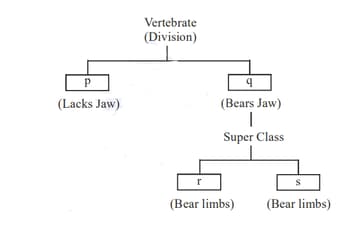MEDIUM
Earn 100
Crocodile, fish and frog, on one hand, and squirrel and crow, on the other hand, differ in the following:
(a)The former have four appendages, the latter have only two
(b)The body temperature of the former changes with environmental temperature, the temperature of the latter remains more or less constant
(c)The former undergo metamorphosis, the latter do not
(d)The former are oviparous the latter are viviparous
76.92% studentsanswered this correctly
Important Questions on Animal Kingdom
HARD
HARD
MEDIUM
EASY
MEDIUM
MEDIUM
Which of the following statements are true for the phylum-Chordata?
(a) In Urochordata, notochord extends from head to tail, and it is present throughout their life.
(b) In Vertebrata, the notochord is present during the embryonic period only.
(c) Central nervous system is dorsal and hollow.
(d) Chordata is divided into 3 subphyla: Hemichordata, Tunicata, and Cephalochordata.
MEDIUM
MEDIUM
Name the classes of Tetrapoda that exhibit the following characters:
| Column (A) | Column (B) |
| Acrodont | Thecodont |
| pairs cranial nerves | pairs cranial nerves |
| Cold-blooded | Warm-blooded |
| Amphicoelous vertebrae | Amphiplatyan vertebrae |
EASY
EASY
EASY
MEDIUM
MEDIUM
a) Chondrichthyes have gill slits covered by operculum and Osteichthyes have gill slits without operculum
b) Chondrichthyes have a swim bladder and Osteichthyes do not have a swim bladder
c) Chondrichthyes contain placoid scales and Osteichthyes contain cycloid scales
d) Chondrichthyes contain terminal mouth and Osteichthyes contain ventral mouth
EASY
EASY
Observe the following simplified scheme and choose the correct option that matches with the letters given in the boxes.

EASY
MEDIUM
Identify the wrongly matched Scientific and common name:
| Scientific name | Common name |
| a) Bungarus | Krait |
| b) Exocoetus | Flying fish |
| c) Trygon | Electric ray |
| d) Carcharodon | Dogfish shark |
| e) Myxine | Hagfish |
MEDIUM
MEDIUM
MEDIUM
Forelimbs are modified into wings and hindlimbs are modified for walking and swimming.
Heart completely four-chambered.
They are homeotherms.
They are oviparous and development is direct.

